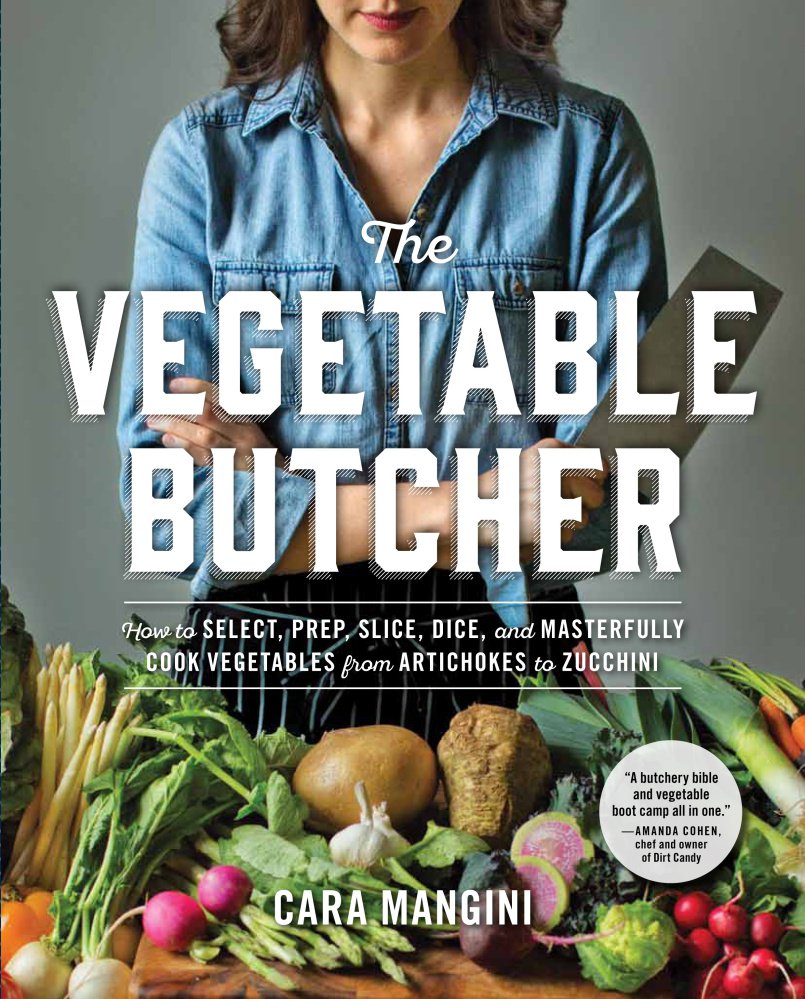“The Vegetable Butcher: How to Select, Prep, Slice, Dice and Masterfully Cook Vegetables from Artichokes to Zucchini.” By Cara Mangini. Workman. $29.95.
“The Vegetable Butcher” by Cara Mangini contains information on every aspect of fresh vegetables, starting with the best season to find, select and store them and ending with their detailed preparation.
The incongruous title refers to Mangini’s message that vegetables can be “butchered” to make main course dishes, not just chopped or cubed for side dishes. Her approach reflects a current trend at many high-end restaurants in America that put vegetables at the center of the plate; Mangini herself worked as a “vegetable butcher” at Eataly in New York.
The first 21 pages of the cookbook, which is vegetarian, are dedicated to types of knives and other tools to show the variety of techniques for slicing and dicing vegetables.
That section is followed by the vegetables themselves, over 50 of them in alphabetical order, beginning with artichokes, and encompassing both the common – such as Brussels sprouts and rutabaga – and the exotic, such as crosnes, jicama, nettles and salsify.
Each vegetable gets a description, a photo of it raw, and a list of “good partners,” all useful information. Step-by-step instructions and more photos demonstrate how to cut and prepare that specific vegetable, followed by recipes, some with full-page photographs of the completed dishes, as well.
The recipe titles (for example, Kohlrabi Carpaccio with Collard Ribbons, Pears, Pistachios, and Lime-Balsamic Vinaigrette) and the list of ingredients are often long, giving the appearance of complicated dishes. But don’t be intimidated. In fact, many are actually fairly simple to make and the ingredients easy to come by. The combinations are often ones I’d have never thought of, especially for the less familiar vegetables.
Most of the cookbook is devoted to savory dishes, for example Smashed and Seared Beets with Chimichurri and Goat Cheese Crema. But Mangini includes some unusual sweet treats as well: Chocolate Avocado Budino with Cinnamon and Sea Salt, and Parsnip-Ginger Layer Cake with Browned Buttercream Frosting are just a couple of the desserts centered around vegetables.
Since my kids have a newly acquired taste for eggplant, I went right to eggplant, even though the “best season” for this vegetable is midsummer to early fall. What can I say? While leafing through this hefty hardback textbook (346 pages), a scrumptious photo of a slice of eggplant sandwiched between tomato and mozzarella cheese and topped with a basil sprig and drizzle of balsamic dressing caught my eye. The recipe opposite this photo is for Eggplant Steaks with Salsa Verde. In my haste, I made the salsa verde before I took a second look and realized the photo I was looking at went with the recipe on the previous page.
There are actually several places in the book where the photo facing a recipe does not correspond to that recipe but to the recipe on a page before or after. To be fair, the full-page photos do have the name of the dish and page number for the recipe in small print at the bottom. You just have to pay attention, something, unfortunately, I don’t always practice when multi-tasking in the kitchen.
The recipe that went with the photo I was looking at was for Eggplant Stacks, not steaks, a simple dish. The recipe calls for grilled eggplant, but as I tested it during springtime in Maine my grill is still covered in snow. The oven-roasted eggplant worked fine; however, I will definitely make this dish again on the grill during the best season for eggplant, when I will also take the salsa verde out of the freezer.
— ANGELA KING-HORNE
EGGPLANT, TOMATO AND MOZZARELLA STACKS WITH PESTO SAUCE AND BALSAMIC REDUCTION
Serves 4-5
1 medium globe eggplant (about a pound) sliced into 1/2-inch rounds
3 tablespoons extra-virgin olive oil

Eggplant, tomato and mozzarella stacks with pesto sauce and balsamic reduction. Photo by Matthew Benson
Fine sea salt
2 to 3 large heirloom tomatoes, sliced into a total of ten 1/4-inch thick rounds
2 small heirloom tomatoes, sliced into a total of 10 1/4-inch-thick rounds
Coarse or flaked sea salt
1/3 to 1/2 cup basil-walnut pesto
6 ounces fresh mozzarella cheese cut into ten 1/4-inch -thick slices
Freshly ground black pepper
Balsamic reduction (recipe follows)
10 fresh basil leaves
Place eggplant rounds in a single layer on a baking sheet, and brush both sides with olive oil. Remove from sheet and grill 4 to 5 minutes per side over medium heat (or leave on sheet and roast at 400 degrees F in the oven about 20 minutes), turning once, until the eggplant flesh is tender through the center, but not completely soft. Return the eggplant to the baking sheet to cool. Sprinkle lightly with fine sea salt.
Line another baking sheet with parchment, and place ten of the largest tomato slices on top in a single layer. Sprinkle each with a pinch of coarse or flaked sea salt. Top each tomato slice with a grilled eggplant round that is the same size or slightly smaller. Spread a small spoonful of pesto over each eggplant round and top it with a slice of mozzarella. Place smaller tomato slices on top of the mozzarella. Sprinkle each tomato slice with a pinch of coarse or flaked sea salt and pepper. Drizzle with the Balsamic Reduction and top each stack with a basil leaf.
BALSAMIC REDUCTION
Makes about 1/4 cup
1 cup balsamic vinegar
Place the vinegar in a small, heavy saucepan and bring to a boil over medium high heat. Reduce the heat to low and gently simmer until the vinegar reduces to about one quarter of its original volume, about 20 minutes.
Check the consistency: should be syrupy and coat the back of a spoon. Simmer slightly longer if needed.
Send questions/comments to the editors.



Comments are no longer available on this story